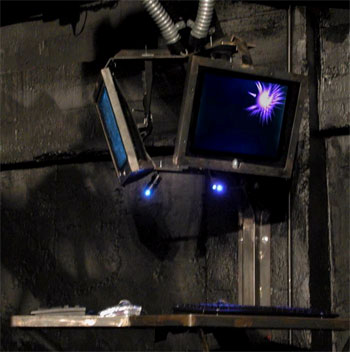Article
Homemade kiosks turn heads at DNA Lounge
An original member of the Navigator/Mozilla design team, Jamie Zawinski is one of the fathers of the modern Web browser. Today, he runs the high-tech-flavored DNA Lounge nightclub, and personally designed and built sleek Internet-access kiosks for its patrons.
March 12, 2006 by James Bickers — Editor, Networld Alliance
That old stereotype that says computer geeks spend all their time in comic book stores is showing its age. No, they're just as likely to be found in social environments of their own making, built according to their rules and designed with an aesthetic that reflects their love for all things futuristic.

In San Francisco, there is probably no hotter geek hangout than the DNA Lounge, home to techno bands one night, hacker conventions and code release parties the next. The club opened in the 1980s, but was purchased in 2000 by Jamie Zawinski, with a goal of making it a "total nerd space."
Zawinski, by that point, was an established nerd, and a high-profile one at that. As one of the original members of the Netscape design team, he helped build version 1.0 of Navigator for Unix. He was also one of the driving forces behind the open-source browser, for which the Mozilla Firefox team can give him thanks.
At the helm of the DNA Lounge, Zawinski turned his efforts toward real-world construction, which occupied the better part of 2001. New walls were poured, a high-end sound system was designed, and lighting and special effects were installed. Appropriately high-tech additions were made as well, like cameras throughout the facility that not only webcast each and every evening's festivities, but send random images of revelers to the network of digital screens scattered about the club.
And then there was the trickiest part of all: putting in a computer device that patrons would actually be able to touch. In keeping with the DNA Lounge's high-tech environment, Zawinski wanted to install Internet kiosks.
"We are a nightclub, which means that our customers arrive here stupid and destructive, and then we feed them alcohol, which makes them even stupider and more destructive," he said. "So, we tried to make these things as bulletproof as possible."
Zawinski said he quickly discovered that off-the-shelf kiosk hardware was too expensive for his purposes, so he set about building his own. He started by putting the computers themselves in a secure box bolted to the wall near the ceiling, connecting them to the user stations with cables that are encased in steel flex-tubing.
"All the computers are diskless and boot off the network," he said. "We've added an extra fan to the cases to keep them cool, as it's a pretty hot environment. It's a nightclub, which means it's a very hostile environment for computers: It's hot, there's constant vibration from the music and a lot of particulates from fog machines. That's why I decided that the machines would all be diskless: The fewer moving parts, the better."

The monitors, 15-inch screens framed in housings of steel and Plexiglas, are suspended above the user's head.
This leaves only the actual interface devices - keyboard and trackball, in this case - to worry about.
"The keyboard and trackball are still subject to abuse, but they are pretty inexpensive, so we just replace those as they break," Zawinski said. "I also looked at industrial keyboards and trackballs, but they're just way too expensive. I'd rather replace a $10 keyboard every month or two than spend $400 on a keyboard that may or may not last a couple of years."
The plan for software and operating system were similarly ambitious. Zawinski said he wanted to allow patrons to use non-Web services like Internet relay chat and instant messaging, so a typical browser lock-down wouldn't work.
His solution was to use a default Linux installation (Red Hat 9 at the moment), auto-logged-in as a guest user. The computers reset themselves to a default state every hour or so, making OS hacking a non-issue.
Despite the hardships of such an ambitious project - from the incredible precautions to the regular maintenance due to heavy usage and vandalism - Zawinski said the kiosks are worth the trouble, and fit in perfectly with the atmosphere and vibe of the DNA Lounge.
"People love them - they get a lot of use," he said. "They're also popular with the staff and visiting performers during the day, who can check their mail and so on without having to drag their laptop around. But we also have free Wi-Fi, in case that's what they'd prefer."
Jamie's diary of the project, along with complete source code, is available at the DNA Lounge Web site.










